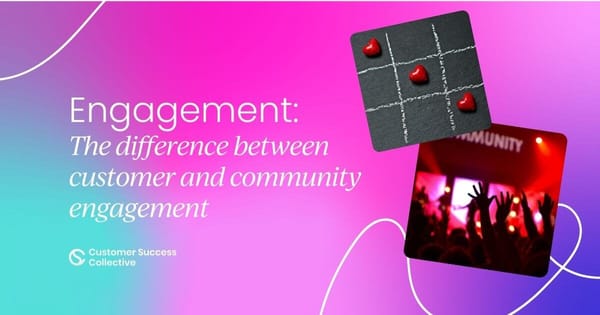Not all forms of engagement are created equal. Understanding the distinctions between customer engagement and community engagement is crucial. While both concepts share common ground in fostering relationships, they serve distinct purposes and require tailored approaches.
In this article, we delve into:
- What engagement is as a concept
- The importance of customer and community engagement
- What the differences are between how these concepts are used
What is engagement?
First, let’s begin by establishing a definition of engagement as a concept within business. In customer success, engagement refers to:
“The process of creating a meaningful and interactive relationship between a brand and its target audience. It is a measure of the level of involvement and interaction that consumers have with a brand or its content.”
Engagement is typically measured through various metrics such as email click-through rate, product adoption, product usage, in-app message responses, and through various sentiment metrics like CSAT scores, health scores and time-to-first-value (TTFV). These metrics are used to gauge the effectiveness of your customer success efforts and produce best practices to drive genuine value for the customer and support brand integrity and image.
Engagement can take many forms, including logging on to use the product, interacting with the brand on social media, opening emails informing the customer of product updates, and interacting with customer communities. Effective engagement strategies are tailored to the specific needs and preferences of the target audience, and they typically involve creating compelling content that resonates with consumers and encourages them to take action.
Ultimately, engagement is a key factor in building brand loyalty and increasing customer retention. By creating meaningful connections with your customers, your brand can foster a sense of community and establish itself as a trusted source of information and inspiration.

The importance of customer engagement
The importance of customer engagement is easily expressed by the fact that a huge component of customer success is engagement, whether that’s engaging with your whole customer base, a specific segment, or an individual customer.
The act of customer engagement supports many of the goals including, but not limited to:
Increasing customer retention
Engaging customers regularly helps to build stronger relationships, which in turn increases the likelihood of customers returning to your brand.
By creating positive experiences and interactions, brands can encourage customers to stay loyal and continue to do business with them. For example, sending personalized emails and offers to customers based on their purchase history can make them feel valued by you, leading to increased retention rates.
Driving customer advocacy
Engaged customers are more likely to recommend your brand to others, which can organically lead to an increase in brand awareness and growth.
Encouraging customers to leave reviews, share their experiences on social media, and participate in referral programs can help to boost advocacy and expand your brand’s customer base.
Enhancing customer experience
Using the various channels at your disposal, such as email, social media, and in-store experiences, you can gain valuable insights into customer preferences and behaviors. This can help tailor what you offer and market to each customer segment.
By doing so, you better meet customer needs and expectations, ultimately leading to a better overall customer experience.
Boosting customer lifetime value
Engaged customers tend to make more repeat purchases and spend more money over time, leading to higher customer lifetime value (CLTV). By keeping customers engaged you can drive long-term revenue growth.
“Building and nurturing customer relationships is a fundamental pillar of advocacy. I truly believe I should be my customers’ biggest advocate, and I show that through action.
“When I first reach out to a customer, I do not initially ask them to participate in any marketing activity. Instead, I offer them a space to get to know each other, share their experiences, and make myself available as an extra resource. I then take the time to personalize their journey by delivering value-based connections aligned with their objectives.
"By putting customers’ interests and goals at the forefront of the opportunities I offer, I am able to build strong customer relationships for long-term engagement, and ultimately, long-term success."
- Valeria Gomez, Manager of Customer Programs at Airtable

Why is community engagement important?
Community engagement is important in community marketing for several reasons. Mainly, because without it, you’ll have a community that’s just sitting there not doing anything. It takes members who are engaging with what you are doing to make the whole act worthwhile.
Our sister community, aptly named Community-Led Alliance, defines community-led growth (CLG) as "a strategy that uses an engaged, supportive community to acquire and retain customers - while expanding the reach of a business."
So, essentially you can’t have a community-led strategy without engagement.
Empowers members
Engaging with the community empowers individuals by giving them a voice in decision-making processes and an opportunity to influence the direction of their community.
Promotes social inclusion
It helps create an inclusive environment that values the contributions of all members, regardless of their backgrounds, experience, or status.
Builds a sense of belonging
Community engagement helps to foster relationships and connections among individuals and their communities, leading to a sense of belonging. This strengthens the overall social fabric within a community and encourages people to continue engaging.
Facilitates problem-solving
By involving community members in identifying and addressing issues, solutions are more likely to be effective, sustainable, and tailored to the specific needs of the community.
Builds trust
Regular and transparent communication between community members and organizations fosters trust, which is crucial for the successful implementation of new projects and initiatives, as well as getting honest and actionable feedback.
Resource sharing and collaboration
Engagement facilitates the sharing of resources, knowledge, and skills among community members and organizations, leading to more efficient and effective outcomes.
In summary, community engagement is essential for creating strong, inclusive, and resilient communities where individuals and organizations work together to address shared challenges and Opportunities.

Understanding the differences between community and customer engagement
Customer engagement and community engagement, although related, have distinct differences in their focus, objectives, and strategies. Here’s a comparison of the two concepts, broken down into focus, objectives, and commonly used strategies:
Customer engagement
1. Focus
Customer engagement primarily revolves around the relationship between a business or organization and its customers or users. It aims to foster long-term relationships and loyalty by creating meaningful interactions with customers.
2. Objectives
The main objectives of customer engagement are to enhance customer satisfaction, increase customer retention, and drive revenue growth. It involves understanding customers’ needs, preferences, and behavior to deliver personalized experiences and improve products or services.
3. Strategies
Customer engagement strategies include offering excellent customer service, providing personalized content or offers, creating user-friendly interfaces, and gathering feedback through surveys or reviews. Social media platforms, email marketing, and loyalty programs are often used to facilitate these strategies.
Community engagement
1. Focus
Community engagement focuses on the relationships and interactions among individuals within a community, which can include businesses, organizations, and residents. It seeks to create a sense of belonging and shared purpose, empowering community members to participate in decision-making processes and work together to address common challenges.
2. Objectives
The main objectives of community engagement are to increase reach and awareness, share knowledge, create brand advocates, and facilitate problem-solving. It aims to create strong, resilient communities that can address shared challenges and opportunities.
3. Strategies
Community engagement strategies involve organizing events, providing resources or platforms for collaboration, and fostering communication and transparency. This can include webinars, workshops, online forums, and social media groups where members can share ideas, knowledge, and experiences.

TL;DR
In summary, customer engagement focuses on the interactions between businesses and their customers, with the goal of driving customer satisfaction, loyalty, and revenue.
Community engagement, on the other hand, emphasizes the relationships and connections within a community, seeking to foster collaboration, inclusivity, and resilience - this, ultimately, is beneficial for the organization or team behind the community in sharing knowledge and spreading awareness of a particular shared interest.
While both strategies share some common elements – and CSMs may be the teams behind these types of communities – each strategy's focus, objectives, and goals are distinct, and understanding those differences is key to executing each strategy well.
Ready to become a customer success maestro?
If you want to master the essential competencies for customer success and accelerate your career, Customer Success Certified: Core is the most comprehensive training out there.
Get ready for a deep dive into every crucial aspect of the CS role.
You’ll uncover cutting-edge strategies for customer onboarding, activation, advocacy, and beyond.
Learn how to:
✅ Tackle churn
✅ Optimize expansion
✅ Ace CS metrics.
This is your chance to equip yourself with the confidence, practical skills, and competitive edge you need to excel. The actionable tools and unparalleled expertise will take your strategies to the next level so you can deliver results.
What are you waiting for? Enroll in Customer Success Certified: Core today and start your journey to CS mastery!



 Follow us on LinkedIn
Follow us on LinkedIn




